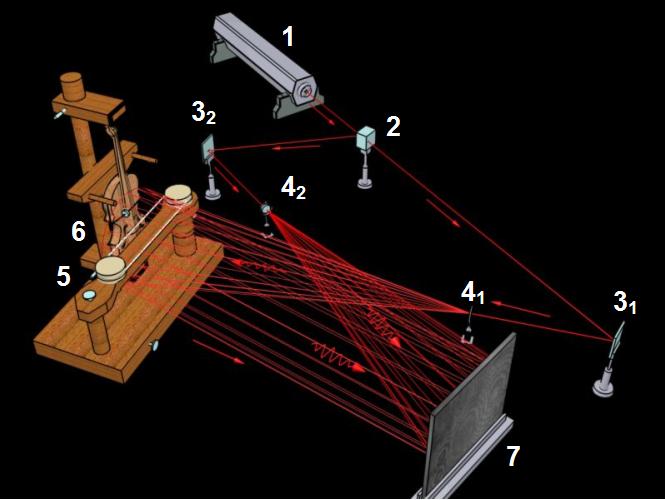Description_of_the_Experiment3
3.2.4.1 Description of the Experiment
From the aspect of statics, by the double-exposure method a concert violin with dark brown varnish was analysed and compared with a "white" non varnished factory violin made in the Strunal Luby u Chebu company, whose soundboards were modified. We investigated the influence of resin extraction on the acoustic properties of the top soundboards. As the extraction compound we used the toluene. The board was dipped in toluene under increased pressure in the ultrasonic field.
The violin was fastened in the testing equipment so that its location was stiff enough and the loading of the boards was close to real conditions with the possibility of repeating the experiments and reproducibility of their results (Fig. 3–43).

1 – laser, 2 – beam splitter, 31, 32 – mirrors, 41, 42 – micro-objective,
5 – infinite bow,6 – violin, 7 – holographic plate
For the holographic-interferometric measurements a holographic set-up was created according to the chart shown in Fig. 3–43.
A narrow laser beam passes through the splitter (2) that transmits more than 80 % of the object beam intensity. The object beam then passes through the micro-objective (41) where it is expanded and, after being reflected from the violin (6) it is incident on holographic plate (7). The reference beam, after being reflected from the splitter (2) and the mirror (32), passes into the micro-objective (42) by which it is expanded and subsequently illuminates the holographic plate (7) where it interferes with the object beam.
For reconstruction of the violin image the same reference beam was used, but beam splitter (2) was replaced by a totally reflecting mirror so that the full laser radiation capacity could be utilised.
By this method the violin body deflections from the side of the soundpost were measured and compared with the calculated values. The method was also used for production of interferograms of the top and bottom soundboards presented in the following section of this chapter.
For all types of holographic recordings by double-exposure method the same experimental set-up was used, but in the case of the violin sides recording the ratio of the object and reference optical paths branches was changed.
During the first exposure, the violin in tuned state was holographically displayed while all strings were acting on the top soundboard through the bridge at value Q = 200 N, during the second exposure the violin body was displayed at Q = 182 N.


